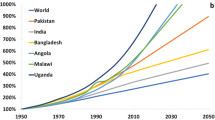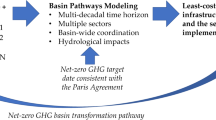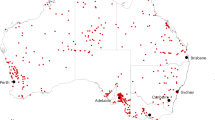Abstract
The United Nations (UN) 1977 Water Conference at Mar del Plata (MDP) sought to avoid a water crisis of global dimensions by 2000 and to ensure an adequate supply of good-quality water to meet socio-economic needs. While much has been achieved, the MDP goals are not yet realized. Unsafe, or perceived to be unsafe, drinking water still affects at least two billion people, unsafe sanitation affects more than four billion people, and billions face severe water scarcity for at least part of the year. At the mid-point of the 2018–2028 International Decade for Action, Water for Sustainable Development, the UN 2023 Water Conference in New York City offers a unique opportunity to review progress on global water goals, including the Sustainable Development Goals, especially Sustainable Development Goal 6 and its targets. Here we document the global goals and progress from MDP to New York City and highlight priorities to deliver on the MDP goals and beyond.
This is a preview of subscription content, access via your institution
Access options
Subscribe to this journal
Receive 12 digital issues and online access to articles
$99.00 per year
only $8.25 per issue
Buy this article
- Purchase on Springer Link
- Instant access to full article PDF
Prices may be subject to local taxes which are calculated during checkout





Similar content being viewed by others
References
Dellapenna, J. W. & Gupta, J. in Elgar Encyclopedia of Environmental Law Vol. X (eds Benidickson, J. & Le Bouthillier, Y.) Ch. X.1 (Edward Elgar, 2021).
Biswas, A. K. From Mar del Plata to Kyoto: an analysis of global water policy dialogue. Glob. Environ. Change 14, 81–88 (2004).
Biswas, A. K. United nations water conference action plan. Int. J. Water Resour. Dev. 4, 148–159 (2004).
Report of the United Nations Water Conference, Mar del Plata E/CONF.70/29 (United Nations, 1977); https://digitallibrary.un.org/record/724642?ln=en
Atlas of Mortality and Economic Losses from Weather, Climate and Water Extremes (1970-2019) (WMO, 2021).
IPCC: Summary for Policy Makers. in Climate Change 2021: The Physical Science Basis (eds Masson-Delmotte, V. et al.) 3–32 (Cambridge Univ. Press, 2021).
Grey, D. et al. Water security in one blue planet: twenty-first century policy challenges for science. Phil. Trans. R. Soc. A 371, 20120406 (2013).
Grafton, R. Q., Williams, J. & Jiang, Q. Possible pathways and tensions in the food and water nexus. Earth Future 5, 449–462 (2017).
The United Nations World Water Development Report 2022: Making the Invisible Visible (UNESCO, 2022).
United Nations 2023 Water Conference Global Online Stakeholder Consultation for the Proposed Themes of the Interactive Dialogues: Summary Report (UNDESA, 2022).
High and Dry: Climate Change, Water, and the Economy (World Bank, 2016).
Sadoff, C. W. et al. Securing Water, Sustaining Growth: Report of the GWP/OECD Task Force on Water Security and Sustainable Growth (Univ. Oxford, 2015); https://agris.fao.org/agris-search/search.do?recordID=QL2018000788
The Global Risks Report 2016 (World Economic Forum, 2016); https://www.weforum.org/reports/the-global-risks-report-2016
Hope, R., Thomson, P., Koehler, J. & Foster, T. Rethinking the economics of rural water in Africa. Oxford Rev. Econ. Policy 36, 171–190 (2020).
Jackson, S. in The Oxford Handbook of Water Politics and Policy (eds Conca, K. & Weinthal, E.) Ch. 6 (Oxford Univ. Press, 2016).
Mueller, J. T. & Gasteyer, S. The widespread and unjust drinking water and clean water crisis in the United States. Nat. Commun. 12, 3544 (2021).
Wyrwoll, P. R., Manero, A., Taylor, K. S., Rose, E. & Quentin Grafton, R. Measuring the gaps in drinking water quality and policy across regional and remote Australia. npj Clean Water 5, 32 (2022).
Gupta, J. & Bosch, H. J. in Water Law (eds Dellapenna, J. W. & Gupta, J.) 315–328 (Edward Elgar, 2021).
Gupta, J. & Bosch, H. in The Cambridge Handbook of the Sustainable Development Goals and International Law (eds Ebbesson, J. & Hey, E.) 163–184 (Cambridge Univ. Press, 2022).
Lai, T. & Tortajada, C. The Holy See and the global environmental movements. Front. Commun. 6, 715900 (2021).
Gupta, J., Pahl-Wostl, C. & Zondervan, R. ‘Glocal’ water governance: a multi-level challenge in the anthropocene. Curr. Opin. Environ. Sustain. 5, 573–580 (2013).
Green, P. A. et al. Freshwater ecosystem services supporting humans: pivoting from water crisis to water solutions. Glob. Environ. Change 34, 108–118 (2015).
Sabater, S. et al. Effects of human-driven water stress on river ecosystems: a meta-analysis. Sci. Rep. 8, 11462 (2018).
Chichilnisky, G. & Heal, G. Economic returns from the biosphere. Nature 391, 629–630 (1998).
Report of the United National Conference on Environment and Development-Rio de Janeiro Vol. I (UN, 1993).
The Dublin Statement and Report of the International Conference on Water and the Environment (UN, 1992); https://wedocs.unep.org/handle/20.500.11822/30961
Pricing Water Resources and Water and Sanitation Services (OECD, 2010); https://doi.org/10.1787/9789264083608-en
Hurlbert, M. & Gupta, J. The adaptive capacity of institutions in Canada, Argentina, and Chile to droughts and floods. Reg. Environ. Change 17, 865–877 (2017).
OECD Principles on Water Governance (OECD, 2015); https://www.oecd.org/governance/oecd-principles-on-water-governance.htm
The United Nations World Water Development Report 2021: Valuing Water (UNESCO World Water Assessment Programme, UN Water, 2021); https://unesdoc.unesco.org/ark:/48223/pf0000375724
Martínez-Santos, P. Does 91% of the world’s population really have “sustainable access to safe drinking water”? Int. J. Water Resour. Dev. 33, 514–533 (2017).
State of the World’s Drinking Water: An Urgent Call to Action to Accelerate Progress on Ensuring Safe Drinking Water for All (WHO, UNICEF & World Bank, 2022).
State of the World’s Sanitation: An Urgent Call to Transform Sanitation for Better Health, Environments, Economies and Societies (UNICEF & WHO, 2020).
A Snapshot of the World’s Water Quality: Towards a Global Assessment (UNEP, 2016).
Podgorski, J. & Berg, M. Global threat of arsenic in groundwater. Science 368, 845–850 (2020).
Framework for Freshwater Ecosystem Management Series 1 (UN Environment, 2017); https://wedocs.unep.org/bitstream/handle/20.500.11822/22243/Framework_Freshwater_Ecosystem_Mgt_vol1.pdf?sequence=1&isAllowed=y
Ma, T. et al. China’s improving inland surface water quality since 2003. Sci. Adv. 6, eaau3798 (2020).
Mostert, E. International co-operation on Rhine water quality 1945–2008: an example to follow? Phys. Chem. Earth Pts A/B/C 34, 142–149 (2009).
Li, X. et al. Water quality analysis of the Yangtze and the Rhine River: a comparative study based on monitoring data from 2007 to 2018. Bull. Environ. Contam. Toxicol. 106, 825–831 (2021).
Drivers of and Pressures Arising from Selected Key Water Management Challenges: A European Overview (European Environment Agency; 2021); https://doi.org/10.2800/059069
National Mission for Clean Ganga (National Informatics Centre, 2022).
Water Supply and Sanitation Policies, Institutions, and Regulation (World Bank, 2022); https://doi.org/10.1596/37922
Shah, T. & Rajan, A. Cleaning the Ganga: rethinking irrigation is key. Econ. Polit. Wkly 54, 57–66 (2019).
SWOT Analysis of the Ganga Action Plan (Indian Institutes of Technology, 2011).
Making Every Drop Count: An Agenda for Water Action (HLPW, 2018); https://sustainabledevelopment.un.org/content/documents/17825HLPW_Outcome.pdf
Brauman, K. A., Richter, B. D., Postel, S., Malsy, M. & Flörke, M. Water depletion: an improved metric for incorporating seasonal and dry-year water scarcity into water risk assessments. Elementa 4, 000083 (2016).
Scanlon, B. R., Jolly, I., Sophocleous, M. & Zhang, L. Global impacts of conversions from natural to agricultural ecosystems on water resources: quantity versus quality. Water Resour. Res. 43, W03437 (2007).
Pérez-Blanco, C. D., Loch, A., Ward, F., Perry, C. & Adamson, D. Agricultural water saving through technologies: a zombie idea. Environ. Res. Lett. 16, 114032 (2021).
Wheeler, S. A., Carmody, E., Grafton, R. Q., Kingsford, R. T. & Zuo, A. The rebound effect on water extraction from subsidising irrigation infrastructure in Australia. Resour. Conserv. Recycl. 159, 104755 (2020).
Grafton, R. Q. et al. The paradox of irrigation efficiency. Science 361, 748–750 (2018).
Gupta, J. The watercourses convention, hydro-hegemony and transboundary water issues. Int. Spectator 51, 118–131 (2016).
McInnes, R. J., Davidson, N. C., Rostron, C. P., Simpson, M. & Finlayson, C. M. A citizen science state of the World’s Wetlands Survey. Wetlands 40, 1577–1593 (2020).
Simpson, M. et al. An updated citizen science state of the world’s wetlands survey. Wetland Sci. Pract. 38, 141–149 (2021).
Davidson, N. C. How much wetland has the world lost? Long-term and recent trends in global wetland area. Mar. Freshwat. Res. 65, 934 (2014).
Davidson, N. C. & Finlayson, C. M. Updating global coastal wetland areas. Mar. Freshwat. Res. 70, 1195 (2019).
Hansen, M. C. et al. High-resolution global maps of 21st-century forest cover change. Science 342, 850–853 (2013).
Wada, Y., Van Beek, L. P. H. & Bierkens, M. F. P. Modelling global water stress of the recent past: on the relative importance of trends in water demand and climate variability. Hydrol. Earth Syst. Sci. 15, 3785–3808 (2011).
Kummu, M. et al. The world’s road to water scarcity: shortage and stress in the 20th century and pathways towards sustainability. Sci. Rep. 6, 38495 (2016).
Satterthwaite, D. The Millennium Development Goals and urban poverty reduction: great expectations and nonsense statistics. Environ. Urban. 15, 179–190 (2003).
Kitzmueller, L., Stacey, B. & Mahler, D. G. Are we there yet? Many countries don’t report progress on all SDGs according to the World Bank’s new Statistical Performance Indicators. World Bank Blogs (10 August 2021); https://blogs.worldbank.org/opendata/are-we-there-yet-many-countries-dont-report-progress-all-sdgs-according-world-banks-new
Vörösmarty, C. J. et al. A green-gray path to global water security and sustainable infrastructure. Glob. Environ. Change 70, 102344 (2021).
Rammelt, C. F. et al. Impacts of meeting minimum access on critical earth systems amidst the Great Inequality. Nat. Sustain. https://doi.org/10.1038/s41893-022-00995-5 (2022).
Steffen, W. et al. Planetary boundaries: guiding human development on a changing planet. Science 347, 1259855 (2015).
McKay, D. I. A. et al. Exceeding 1.5 °C global warming could trigger multiple climate tipping points. Science 377, https://doi.org/10.1126/science.abn7950 (2022).
Reason, J. A systems approach to organizational error. Ergonomics 38, 1708–1721 (1995).
Biswas, A. K., Sachdeva, P. K. & Tortajada, C. Phnom Penh Water Story (Springer, 2021).
du Pisani, P. L. Surviving in an arid land: direct reclamation of potable water at Windhoek’s Goreangab Reclamation Plant. Arid Lands. 56, 1–11 (2004).
Luo, P. et al. Water quality trend assessment in Jakarta: a rapidly growing Asian megacity. PLoS ONE 14, e0219009 (2019).
Patel, P. P., Mondal, S. & Ghosh, K. G. Some respite for India’s dirtiest river? Examining the Yamuna’s water quality at Delhi during the COVID-19 lockdown period. Sci. Total Environ. 744, 140851 (2020).
Capone, D., Cumming, O., Nichols, D. & Brown, J. Water and sanitation in urban America, 2017–2019. Am. J. Public Health 110, 1567–1572 (2020).
Andres, L. A. et al. Doing More with Less: Smarter Subsidies for Water Supply and Sanitation (World Bank, 2019); http://documents.worldbank.org/curated/en/330841560517317845/Doing-More-with-Less-Smarter-Subsidies-for-Water-Supply-and-Sanitation
Hutton, G. & Varughese, M. The Costs of Meeting the 2030 Sustainable Development Goal Targets on Drinking Water, Sanitation, and Hygiene (World Bank, 2016); https://openknowledge.worldbank.org/bitstream/handle/10986/23681/K8632.pdf?sequence=4
Financing a Water Secure Future (OECD, 2022); https://doi.org/10.1787/a2ecb261-en
Ashendorff, A. et al. Watershed protection for New York City’s supply. J. Am. Water Works Assoc. 89, 75–88 (1997).
Wagner, W. et al. Sustainable watershed management: an international multi-watershed case study. AMBIO 31, 2–13 (2002).
McDonald, R. I., Weber, K. F., Padowski, J., Boucher, T. & Shemie, D. Estimating watershed degradation over the last century and its impact on water-treatment costs for the world’s large cities. Proc. Natl Acad. Sci. USA 113, 9117–9122 (2016).
Chung, M. G., Frank, K. A., Pokhrel, Y., Dietz, T. & Liu, J. Natural infrastructure in sustaining global urban freshwater ecosystem services. Nat. Sustain. 4, 1068–1075 (2021).
Tortajada, C., Koh, R., Bindal, I. & Lim, W.-K. Compounding focusing events as windows of opportunity for flood management policy transitions in Singapore. J. Hydrol. 599, 126345 (2021).
Williams, J. et al. The three-infrastructures framework and water risks in the Murray-Darling Basin, Australia. Australas. J. Water Resour. https://doi.org/10.1080/13241583.2022.2151106 (2022).
Anderson, C. C., Renaud, F. G., Hanscomb, S. & Gonzalez-Ollauri, A. Green, hybrid, or grey disaster risk reduction measures: what shapes public preferences for nature-based solutions? J. Environ. Manage. 310, 114727 (2022).
Global Water Policy Report 2021: Listening to National Water Leaders (Water Policy Group, 2021); http://waterpolicygroup.com/wp-content/uploads/2022/02/2021-Global-Water-Policy-Report-4-Feb-2022.pdf
Transparency International Global Corruption Report 2008: Corruption in the Water Sector (Cambridge Univ. Press, 2008).
Grafton, R. Q. & Williams, J. Rent-seeking behaviour and regulatory capture in the Murray-Darling Basin, Australia. Int. J. Water Resour. Dev. 36, 484–504 (2020).
Thompson, D. F. Mediated corruption: the case of the Keating Five. Am. Polit. Sci. Rev. 87, 369–381 (1993).
Swyngedouw, E. & Boelens, R. in Water Justice (eds Boelens, R. et al.) 115–133 (Cambridge Univ. Press, 2018).
Repetto, R. Skimming the Water: Rent-Seeking and the Performance of Public Irrigation Systems, 4 (World Resources Institute, 1986); https://pdf.usaid.gov/pdf_docs/PNAAW837.pdf
Garrick, D. E. et al. Valuing water for sustainable development. Science 358, 1003–1005 (2017).
Grafton, R. Q., Horne, J. & Wheeler, S. A. in Oxford Research Encyclopedia of Environmental Science (Oxford Univ. Press, 2022); https://doi.org/10.1093/acrefore/9780199389414.013.800
Hartwig, L. D., Jackson, S., Markham, F. & Osborne, N. Water colonialism and Indigenous water justice in south-eastern Australia. Int. J. Water Resour. Dev. 38, 30–63 (2021).
Grafton, R. Q. Policy review of water reform in the Murray-Darling Basin, Australia: the “do’s” and “do’nots”. Austr. J. Agric. Resour. Econ. 63, 116–141 (2019).
Grafton, R. Q., Chu, L. & Wyrwoll, P. The paradox of water pricing: dichotomies, dilemmas, and decisions. Oxford Rev. Econ. Policy 36, 86–107 (2020).
Grafton, R. Q., Ward, M. B., To, H. & Kompas, T. Determinants of residential water consumption: evidence and analysis from a 10-country household survey. Water Resour. Res. 47, W08537 (2011).
Chu, L. & Grafton, R. Q. Dynamic water pricing and the risk adjusted user cost (RAUC). Water Resour. Econ. 35, 100181 (2021).
Kjellén, M. & Mcgranahan, G. Informal Water Vendors and the Urban Poor Human Settlements Discussion Paper 3 (IIED, 2006).
Bhatia, R. & Falkenmark, M. Water Resource Policies and the Urban Poor: Innovative Approaches and Policy Imperatives (International Bank for Reconstruction and Development/World Bank, 1993); https://documents1.worldbank.org/curated/en/110731468319494040/pdf/multi-page.pdf
Kjellen, M. Complementary water systems in Dar es Salaam, Tanzania: the case of water vending. Int. J. Water Resour. Dev. 16, 143–154 (2000).
Khan, H. R. & Siddique, Q. I. Urban water management problems in developing countries with particular reference to Bangladesh. Int. J. Water Resour. Dev. 16, 21–33 (2000).
Schwind, A. SDG 6: Targets and Indicators. Sustaining Development (1 April 2019); https://sustainingdevelopment.com/sdg6-indicators/
The Global Wetland Outlook: Special Edition 2021 (Ramsar, 2021); https://static1.squarespace.com/static/5b256c78e17ba335ea89fe1f/t/61b8a904f3ceb458e9b5ca44/1639491853578/Ramsar+GWO_Special+Edition+2021–ENGLISH_WEB.pdf
Resolution A/RES/64/292 (United Nations General Assembly, 2010).
General Comment No. 15. The Right to Water (UN Committee on Economic, Social and Cultural Rights, 2002).
Acknowledgements
We are grateful to the Netherlands Enterprise Agency, which provided a partial subsidy for H.B., S.F. and N.S.
Author information
Authors and Affiliations
Corresponding author
Ethics declarations
Competing interests
The authors declare no competing interests.
Peer review
Peer review information
Nature Water thanks Barbara Van Koppen and Guillermo Donoso for their contribution to the peer review of this work.
Additional information
Publisher’s note Springer Nature remains neutral with regard to jurisdictional claims in published maps and institutional affiliations.
Rights and permissions
Springer Nature or its licensor (e.g. a society or other partner) holds exclusive rights to this article under a publishing agreement with the author(s) or other rightsholder(s); author self-archiving of the accepted manuscript version of this article is solely governed by the terms of such publishing agreement and applicable law.
About this article
Cite this article
Quentin Grafton, R., Biswas, A.K., Bosch, H. et al. Goals, progress and priorities from Mar del Plata in 1977 to New York in 2023. Nat Water 1, 230–240 (2023). https://doi.org/10.1038/s44221-023-00041-4
Received:
Accepted:
Published:
Issue Date:
DOI: https://doi.org/10.1038/s44221-023-00041-4
This article is cited by
-
Benefits, costs and enabling conditions to achieve ‘water for all’ in rural and remote Australia
Nature Water (2024)
-
Water woes: the institutional challenges in achieving SDG 6
Sustainable Earth Reviews (2023)
-
Not all risks are equal: a risk governance framework for assessing the water SDG
International Environmental Agreements: Politics, Law and Economics (2023)



